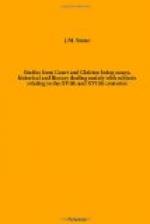* Strype, Life of Archbishop Grindal, p. 25.
** Acts and Monuments, i. 69 1. Edited 1570.
But it is not for his want of scholarly writing that Foxe has been blamed. Father Robert Persons, in his Three Conversions of England,* begins one of his chapters with “a note of more than a hundred and twenty lies uttered by John Foxe, in less than three leaves of his Acts and Monuments,” and he proceeds to point them out, beginning with the misstatement concerning John Merbeck and some others, whom Foxe counts among the martyrs, although they were never burned at all. As, in consequence of Father Persons’ remarks concerning John Merbeck, Foxe acknowledged the error in his second edition, we may hold him excused thus far, but his delinquencies in this respect were by no means unfrequent, and gave rise to the saying that “many who were burnt in the reign of Queen Mary, drank sack in the reign of Queen Elizabeth."**
* Quoted in Fuller’s Worthies, under “Berkshire,” p. 92.
Part iii., p. 412.”
Two similar misstatements, which he was in a position to correct and did not, relate to the supposed death by the vengeance of God, of Henry Morgan, Bishop of St. David’s, and of one Grimwood, another “notorious Papist.”
Anthony a Wood, the famous antiquary and historian, who wrote his History of the Antiquities of Oxford about a hundred years after Foxe had become celebrated as a martyrologist, and who in his youth spoke with people who remembered the days of persecution under Mary, tells us that:—




